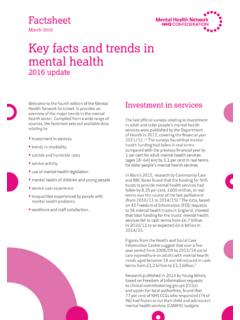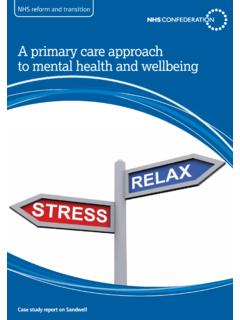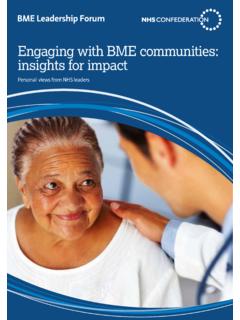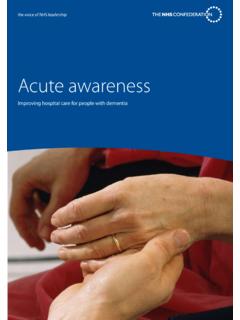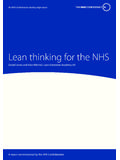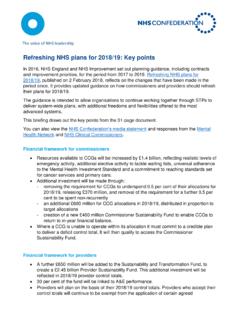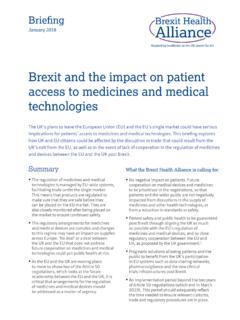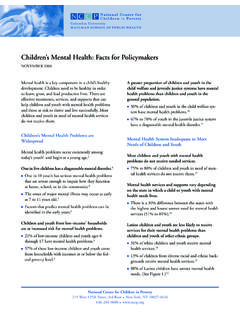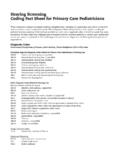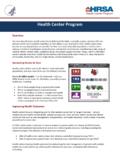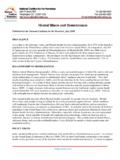Transcription of March 2016 Key facts and trends in mental health
1 March 2016 FactsheetWelcome to the fourth edition of the mental health Network factsheet. It provides an overview of the major trends in the mental health sector. Compiled from a wide range of sources, the factsheet sets out available data relating to: investment in services trends in morbidity suicide and homicide rates service activity use of mental health legislation mental health of children and young people service user experience inequalities experienced by people with mental health problems workforce and staff facts and trends in mental health2016 updateInvestment in servicesThe last official surveys relating to investment in adult and older people s mental health services were published by the Department of health in 2012, covering the financial year 2011 ,2 The surveys found that mental health funding had fallen in real terms compared with the previous financial year by 1 per cent for adult mental health services (ages 18 64)
2 And by per cent in real terms for older people s mental health March 2015, research by Community Care and BBC News found that the funding for NHS trusts to provide mental health services had fallen by per cent, 600 million, in real terms over the course of the last parliament (from 2010/11 to 2014/15).3 The data, based on 43 Freedom of Information (FOI) requests to 56 mental health trusts in England, showed that total funding for the trusts mental health services fell in cash terms from billion in 2010/11 to an expected billion in 2014 from the health and Social Care Information Centre suggest that over a five-year period from 2008/09 to 2013/14 social care expenditure on adults with mental health needs aged between 18 and 64 reduced in cash terms from billion to Research published in 2014 by Young Minds, based on Freedom of Information requests to clinical commissioning groups (CCGs) and upper tier local authorities, found that 77 per cent of NHS CCGs who responded (74 of 96) had frozen or cut their child and adolescent mental health services (CAMHS)
3 Budgets 02 Suicide and homicideThe latest report of the National Confidential Inquiry into Suicide and Homicide with People with mental Illness was published in 2003 2013 in England, 13,972 deaths (28 per cent of general population suicides) were identified as patient suicides, where the person concerned had been in contact with mental health services in the 12 months prior to their death. This represents an average of 1,270 patient suicides per year over the general, the report says: Patient suicides in the UK have become substantially more common since 2009 1,876 in 2013 but this rise is mainly the result of a rise in England where patient numbers overall have also increased. As a proportion of all suicides, patient suicides have increased from 27 per cent in 2003 to 30 per cent in 2013. The report states: This may similarly reflect a rise in patient numbers, though safety problems in care may contribute. A higher proportion of patients could also occur if services improve access and long-term contact for people at high risk.
4 The annual number of suicides among male patients has been increasing since 2006 in England, while for females the number has fallen between 2003 and 2012. The rise in male patients since 2006 is 34 per cent, whereas the general population rise in males is 15 per cent. The annual number of suicides in male patients aged 25 34 has fallen in the report period and there has also been a fall in female patients aged 65+. The rise in male patients aged 45 54 has been particularly striking, around 90 per cent since 2003 to 2012, there was a 61 per cent fall in the number of inpatient suicides in the 2003 to 2013 period there was an average of 57 patient homicides per year in England. There was a fall in the number of patient homicides over the whole report period when examined by year of conviction, and by year of offence. However, the report states: This fall has not continued after 2009 and there may have been an increase in 2013, as our current confirmed figure is higher than at the same point in data collection in previous years.
5 12between 2013/14 and 2014/15. Sixty per cent of local authority respondents (59 of 98) had either cut or frozen their CAMHS budgets since 2010 UK invests 115 million per year on mental health research. mental health receives per cent of the UK health research spend. Approximately is spent on research per person affected by mental health in morbidityThe health and Social Care Information Centre expects to publish the results of the 2014 Adult psychiatric morbidity survey by late 2016. The 2007 adult psychiatric morbidity survey found that the proportion of the English population aged between 16 and 64 meeting the criteria for one common mental disorder increased from per cent in 1993 to per cent in 2007. Twenty-four per cent of those with a common mental disorder were receiving in December 2015 by the health and Social Care Information Centre, the 2014 health survey for England found that 26 per cent of adults reported having ever been diagnosed with at least one mental health were more likely than men to report ever having been diagnosed with a mental health problem (33 per cent compared with 19 per cent).
6 Nineteen per cent of adults reported that they had ever been diagnosed with depression, including post-natal depression. This was the most frequently reported diagnosis. People from lower income households were more likely to have ever been diagnosed with a mental health problem. Twenty-seven per cent of men and 42 per cent of women in the lowest income quintile reported this, compared with 15 per cent of men and 25 per cent of women in the highest income 2030, it is estimated that there will be approximately two million more adults in the UK with mental health problems than there were in 2016 Key facts and trends in mental healthInpatient careFrom the same data, 103,840 service users ( per cent) spent time in hospital during 2014/15. This is a decrease compared to 2013/14, when per cent (105,270) of service users spent time in hospital. This is a continuation of the trend seen in earlier 2014/15, people in contact with mental health and learning disability services spent a total of 8,523,323 days in hospital, in the year.
7 This is an increase of 395,180 bed days, or per cent, when compared to the figure from 2013/14 (8,128,143). This increase is said to be largely a result of the expansion of the scope of the dataset to include people in contact with learning disability services for the first the same year, the median in year bed days for each adult mental health or learning disabilities care spell that spent some time in hospital was days. The median for NHS providers was days, and for independent sector providers the median was days. It should be noted that not all independent sector providers submitted data, and that long inpatient stays are expected for some types of services typically provided by independent sector providers (traditionally long-term complex care or forensic services).18 Service activityResearch by Community Care and BBC News, based on data obtained from 34 trusts under the Freedom of Information Act, found that between 2010/11 and 2014/15 average referrals to community mental health teams had increased by 19 per cent, and to crisis and home treatment teams by 18 per cent.
8 Referrals to early intervention in psychosis services had increased by 4 per cent over the same period. The researchers caution however that some trusts had absorbed outreach, early intervention and crisis functions into community mental health teams, which may impact on these headline of 2014/15 health and Social Care Information Centre data shows that almost two million people (1,835,996) were in contact with mental health and learning disability services at some point in the year, an increase of 89,298 ( per cent) on the previous year. This means that 3,617 people per 100,000 of the population in England accessed mental health and learning disability services (approximately one person in 28).14 Over one million women (1,004,227) were in contact with mental health and learning disability services in 2014/15. This is higher than the number of men (829,677) and equates to per cent of the total number of people over the 1. People in contact with mental health and learning disability services by highest level of care and year 2003/04 2014/15 Source: health & Social Care Information Centre (October 2015a)2,400,0002,000,0001,600,0001,200,0 00800,000400,0002003/042004/52005/062006 /072007/082008/092009/102010/112011/1220 12/132013/142014/1512%10%8%6%Percent admittedNumber of people4%2%People in contact with servicesPercent admitted04 mental health legislationMental health Act The mental health Act 1983 was used more than 58,000 times to detain people in 2014/15, representing the highest ever year-on-year increase ever (approximately 10 per cent).
9 Fifty-one per cent of mental health inpatients were subject to the Act. Overall, this represents an increase of 8,982 (18 per cent) since the CQC began monitoring the Act in 2009 31 March 2015, the health and Social Care Information Centre reported that there were a total of 25,117 people subject to the Act. Of these, 19,656 were detained in hospital and 5,461 were being treated under community treatment orders (CTOs).25 Overrepresentation of some black and minority ethnic (BME) groups in the detained population has been widely reported for many years, with compulsory admission rates for people of black ethnicity almost three times greater than those of white patients. The CQC report that compulsory admission rates of black people tend to be highest in areas with higher levels of deprivation and areas where there is a higher proportion of non-white 2014/15, detentions on admission to hospital increased by 2,903 ( per cent). There was a larger percentage increase in detentions following an informal admission, which rose by per cent (1,991).
10 The total number of detentions increased in NHS hospitals by 3,995 ( per cent) compared to the year before to reach 51,969 and in independent sector hospitals by 1,268 ( per cent) to 6,430. The increase in detentions was mainly attributable to uses of Part II of the Act (Civil Detentions) with very little change in the number of detentions under Part III of the Act (Court and Prison Disposals). Uses of Section 3 following the use of Section 2 have increased year on year between 2010/11, where there were 6,617 uses recorded, and 2014/15, where there were 10,787 uses. This represents an increase of 4,170 uses, or per cent over the last five number of instances where section 136 of the Act was used to make a short-term detention to a hospital as a place of safety increased by 2,400 (or per cent) to 19,400, compared to the year is not routinely collected for numbers of acute adult beds. However, March 2015 figures from NHS Benchmarking, cited by the recent Commission to Review the Provision of Acute Inpatient Psychiatric Care for Adults, indicated that there are 6,144 acute adult NHS beds in England, down per cent on the year before.
